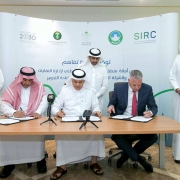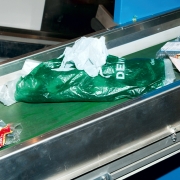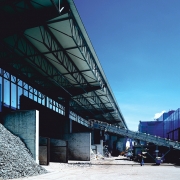Kuwait: More Additional Waste Management Facilities Needed
In April 2017, the Kuwait official environmental portal Beatona announced that “Kuwait pushed towards ‘zero landfills‘ by creating recycling plants. Efforts are still underway as three landfills are remaining. Experts expect Kuwait to reach ‚zero landfills‘ over the next few years”. This assessment seems to be slightly too optimistic.
There can be no doubt, that landfilling is the prevalent solid waste management method. In October 2016, Kuwait counted 18 landfills. But as most of them were acting as dumpsites and did not meet international environmental standards, 14 sites facing capacity and environmental issues were closed years before, and only four sites were left in operation. And – as a study underlined in 2014 – no landfill met the criteria of a sanitary landfill. This will not be enough to face the future. A forecast in 2014 saw the increase of “population solid waste” from 1.42 million tons in 2012 to 2.31 million tons in 2025 and – moreover – the rise of construction waste from 5.02 million tons to 7.51 million tons. Two years later a study warned: “The incremental population in Kuwait results in a dramatic increase in the MSW and unfortunately the waste management system in the region has not been properly managed, yet.” According to its researchers, no governmental scheme existed in Kuwait for municipal waste recycling and segregation of waste occured manually at landfill sites.
Poor practices
“Kuwait had been plagued by the problem of waste management and rehabilitation”, Sheikh Abdullah Ahmad Al-Hammoud Assubah, Chairman of the Board of Directors of the General Environment Authority, confessed in January 2018. He blamed the “cleaning companies” for exploiting inappropriate quarry pits for purposes of filling and disposing of. In fact, the previous collection and transportation of municipal waste involved poor practices by municipalities and contractors, as no segregation of materials was performed and the waste was delivered directly to the disposal sites. Although the composition of the Kuwaiti MSW stream is comprising of 21 percent paper and cardboard, of 13 percent plastics, of five percent textiles and of three percent glass and metals each – raw materials fitting perfectly for recycling.
Revenue of 137 million US-Dollar
According to a study on an “Integrated Solid Waste Management System” published in 2016, 76.2 percent of Kuwait’s waste could be recyclable. By installing seven recycling plants, 95 percent of waste tires and organic waste, 90 percent of construction and demolition waste, glass and metal, 80 percent of paper and 50 percent of plastic could be recycled. The remaining non-recyclable materials would be sent to a sanitary landfill. The raw materials produced by the recycling plants could generate revenue of 137 million US-Dollar per year. The estimated total profit from the system would reach 450 million US-Dollar in 2040; meaning a payback period of 9.5 years since the beginning of the project.
Only a few recycling companies
The reality looks somewhat different. The cited study also pointed out that “only a few recycling companies” were active in Kuwait, “dealing with a small portion of the discarded materials”. Or – as the Kuwait Direct Investment Promotion Authority (KDIPA) expressed it – “waste recycling as a concept is relatively new in Kuwait with only a few active players”. But it would urgently be necessary because of factors like strong growth in the energy sector, growing construction activities, increasing population and rapid urbanization. They will force the annual solid waste generation to rise from 12.5 million tons in 2014 to – anticipated – more than 17.1 million tons by 2019. According to KDIPA, the Kuwait Environment Public Authority (KEPA) and the Kuwait Municipality decided to take initiatives to encourage better management of solid waste, “moving away from the past practice of dumping untreated waste at landfill sites”. The Kuwait Government was even seeking “to involve the private sector in the area of solid waste treatment with a view to bring in international expertise and private sector efficiencies”.
The Kabd Municipal Solid Waste Project
In October 2014, a project to build Kuwait’s first plant for the thermal treatment of waste was launched. The one million tons waste-to-energy plant was considered to be “an effective solution to address Kuwait’s waste management problem”, the Partnerships Technical Bureau, responsible for Kuwaiti PPP projects implementation, estimated. The solid waste treatment plant with a capacity of 3,275 tons per day will consist of four combustion lines, combustion furnace, energy recovery boiler, fuel gas cleaning system, slag treatment plant and turbine generator. In August 2017, a consortium joined by Constructions Industrielles de La Méditerranée, Gulf Investment Corporation and Al Mulla Group was selected as preferred investor for the so-called Kabd Municipal Solid Waste Project. It is planned to receive 50 percent of total Kuwaiti municipal solid waste and is rated as “an example for subsequent waste to energy projects in the MENA region”. The commissioning of the new plant has not yet been reported.
Of 32,000 tons of total solid waste that are produced per day in Kuwait, only 6,700 tons or 21 percent are recycled and used as recyclates for reusable products such as scrap plastic products, flakes, and other scrap materials. As KDIPA gives account, high-value waste components such as metals have attracted interest from recycling companies. But for more complex components such as plastics or less valued materials like fibers, wood, glass and paper there is more need for the establishment of adequate facilities. The study on the “Integrated SWM System” certifies “minimalistic attempts” of recycling occurring for plastic solid waste, metal and steel in processing lines of private holding companies, but also poor waste recycling and accumulation levels. Incentives could be offered by lowering manufacturing and energy costs for recycled materials and increase the demand for waste recycling. Therefore – argues the study – implementing an Integrated Solid Waste Management System (ISWMS) action plan could achieve financial and environmental benefits.
Pilot projects for hazardous waste
Regarding the 5.21 million tons of hazardous waste in 2014, about one-third was oily water, another third asbestos and another third contaminated soil. Oil contaminated soil and oily sludge are attributable to activities of the Kuwait Oil Company, treated by bioremediation or soil washing processes and recycled back to crude oil recovery plants or re-used for various backfilling purposes. As the country also plans to increase its oil production capacity nine-fold (and thus to quadruple the recoverable crude oil from oil sludge), the Kuwait Oil Company is said to undertake pilot projects to explore technologies for prevention of environmental contamination and potential for recovery of oil. Following KDIPA, this “is an opportunity for international specialists to bring in comprehensive technology solutions to address these issues in Kuwait”. Even more, as “separately there are around 114 square kilometers of oil wells that were created as a result of oil spills from damage caused by the retreating Iraqi army in 1991”.
The recycling branch could disappear
Shakir Al-Essa, General Manager of Safya International Import and Export Company, does not admit that Kuwait is an attractive environment for investments in recycling. He even fears that the by-date recycling branch could completely disappear. Before the financial crisis year 2008, the small operating recycling companies could treat their materials and sell their products to several customers inside and outside Kuwait. The competition was effective, and the price of metals was high. Later on, the government issued decisions to ban the export of metals: Prices fell, and the ministry of commerce froze them. Even the number of thefts on recyclable products like refrigerator or manhole covers decreased by the devaluation of metal. Furthermore, the new public-private partnership could harm the existing companies. The recycling process needs collecting municipalities, material separating companies and recycling factories. If the resources will be taken over by the consortium, the factories will run out of material. The same will happen, if the waste for the new project is taken from landfills: 90 percent of the factories’ resources originate from landfill material; their loss through usage by the new investor would lead to the closure of the small companies and the ruin of the grown structures. “This will kill the business of recycling factories”, Al-Essa is convinced.
Need for additional facilities
In June 2016 – after controlling and limiting toxic fumes – KEPA transformed the Al-Qurain dump site into a public park and delivered it to Kuwait Municipality. Dr. Mohammed Al-Ahmad, Deputy Director General for Sector of Environmental Monitoring Affairs, commented that handing over the park came in accordance with the new environmental protection law and fulfilling requests to forward landfills to competent entities.
The act and its justification show that something is changing and improving the national waste management and its policy. Experts even estimate, that 95 percent of waste should and could be recycled. But measured by actions, Kuwait still has a way to go. Or, as the Kuwait Direct Investment Promotion Authority phrased it: “In comparison to European countries, landfills remain the dominant method of solid waste disposal in Kuwait, driving the need for additional waste management facilities.”
Photo: pixabay
GR 12019








